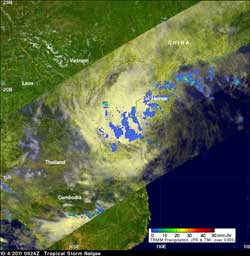NASA Eyes Light Rainfall in Dissipating Tropical Depression Nalgae

This TRMM satellite rainfall image shows only scattered areas of light to moderate rainfall (green and blue, falling at a rate between .78 to 1.57 inches/20 to 40 mm per hour) were present with Nalgae as it moved into the Gulf of Tonkin west of Hainan Island. Credit: NASA Earth Observatory/TRMM/NASA Goddard/Jesse Allen <br>
TRMM measured the rainfall rates in Nalgae on October 4, 2011 at 0624 UTC (2:24 a.m. EDT). The rainfall analysis from TRMM's Microwave Imager (TMI) and Precipitation Radar (PR) showed only scattered areas of light to moderate rainfall were present with Nalgae as it moved into the Gulf of Tonkin west of Hainan Island. Rain was falling at a rate between .78 to 1.57 inches/20 to 40 mm per hour.
By October 5 at 1500 UTC (11 a.m. EDT), Nalgae had weakened into a remnant low pressure area with maximum sustained winds of 20 knots (23 mph/37 kmh) around its circulation center. It was located about 100 nautical miles north of Hue, Vietnam near 18.0 North and 107.3 East. The remnant low was drifting to the west-southwest at 2 knots (2 mph/4 kmh).
The forecasters at the Joint Typhoon Warning Center noted that the movement across Hainan Island weakened the system beyond the point of regeneration. There was no convection (rising air that forms thunderstorms that make up a tropical depression) evident today, Oct. 5. The remnant low is drifting to the coast today.
Text credit: Rob Gutro
NASA/Goddard Space Flight Center, Greenbelt, Md.
Media Contact
All latest news from the category: Earth Sciences
Earth Sciences (also referred to as Geosciences), which deals with basic issues surrounding our planet, plays a vital role in the area of energy and raw materials supply.
Earth Sciences comprises subjects such as geology, geography, geological informatics, paleontology, mineralogy, petrography, crystallography, geophysics, geodesy, glaciology, cartography, photogrammetry, meteorology and seismology, early-warning systems, earthquake research and polar research.
Newest articles

A universal framework for spatial biology
SpatialData is a freely accessible tool to unify and integrate data from different omics technologies accounting for spatial information, which can provide holistic insights into health and disease. Biological processes…

How complex biological processes arise
A $20 million grant from the U.S. National Science Foundation (NSF) will support the establishment and operation of the National Synthesis Center for Emergence in the Molecular and Cellular Sciences (NCEMS) at…

Airborne single-photon lidar system achieves high-resolution 3D imaging
Compact, low-power system opens doors for photon-efficient drone and satellite-based environmental monitoring and mapping. Researchers have developed a compact and lightweight single-photon airborne lidar system that can acquire high-resolution 3D…





















